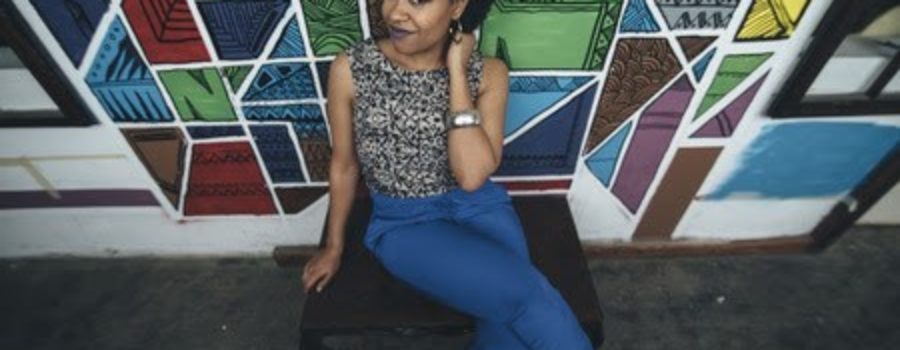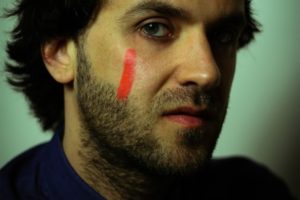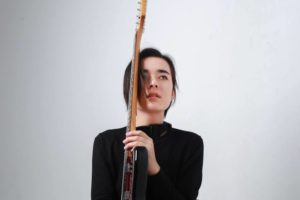The first two years of Meklit’s life was spent in Addis Ababa, Ethiopia before her family relocated to the U.S. While it was a short time and they left when she’d barely reached her toddler stage, her roots were already planted. She notes, “My first language was Amharic, even though my first memories are in Iowa.” Instead of diving fully into their new American life, her family allowed for the natural combination of their Ethiopian heritage and their new home flow into Meklit’s life.
“I grew up listening to both Ethiopian music and American music and felt an affinity and connection to both. I think in that way, I’m constantly playing with the familiar and unfamiliar,” adding, “Often to an American audience, the Ethiopian 6/8 rhythms and pentatonic melodies are new to their ears, but the songs are mostly in English and they can feel the singer-songwriter and the Jazz inside of them. On the other hand, an Ethiopian audience will recognize the elements I just mentioned and maybe even the song itself – for example when I reinterpret a traditional song – but the swing is somehow American. I love playing with that in-betweenness. That’s who I am.”
While only there a couple of years, we talked about where she once called home in Ethiopia, where she calls home now in San Francisco and all the music and art that came in between.

Kendra: What’s the biggest misconception people have when it comes to Ethiopia?
Meklit: We all know what they are because we’ve heard them our whole lives in reference to Africa as a whole: poverty, chaos, despair. And yes there is poverty of course, but it is far from the whole story. In fact, Ethiopia is so big, it’s hard to pin down…There are 80 languages and ethnic groups, 300 dialects, and nearly 100 million people (which is almost ⅓ the population of the US). It is full of a strong and deep history, ancient empires, freedom from colonialism, and people who brim with love of family and culture. Ethiopians love Ethiopian things…music, fashion, business.
They sing in double entendres and have a proverb for every occasion. They are complex, with dreams, wishes, and hopes for the future like everyone on this earth. They are proud, creative, and they work hard for themselves and their families. A huge percentage of the people are farmers, but the cities are exploding with growth and change. In fact, it changes every time I am there, with new buildings going up faster than you can imagine. The musicians are virtuosic, and the singers know how to make you cry with their melodic invitations to remember your own past. The feeling is the thing. When I am there, time slows down, a kind of pressure abates, and you get closer to the people around you. That’s what I have to say about that.
Kendra: When you came to the states you were all over the place. What made San Francisco feel like home?
Meklit: Home is so intangible, isn’t it? But once I got to San Francisco, everything started to bloom. My work found root, much more quickly than I imagined. Music called me strong, and I found support for that in the artistic community. I never had that before. It made me devoted to this beautiful place.
Kendra: Speaking of San Francisco, if you had to compare your latest release, When The People Move, The Music Moves Too, to a place in your city where would it be and why?
Meklit: At the top of Tilden Park in Berkeley, there is a view that takes your breath away. I call it my big picture view. From there, you can see how all the cities fit together…San Francisco, Oakland, Berkeley, Marin. I think this album is about a big picture view and about how culture fits together, seamlessly like a path on a map.
Kendra: Other than your music, what is one artist who never fails to make you move?
Meklit: I’m going to go outside of music for a moment and name my very favorite sculptor, James Turrell. He creates these skyspaces that you can walk into. They have the most incredible acoustics and they are open to the sky. Every day at sunset there is a light installation as well. The de Young Museum in Golden Gate Park has one and in 2009, I was an artist in residence there. I would spend all day inside of it, singing, and watching people. The space would inevitably make them sink into themselves, and release some kind of tension. Turrell is a sculptor of light and concrete, but he is also kind of a sculptor of the state of being of his audiences. He moves me every time.
Musically, I’m listening to Mulatu Astatke, Somi, Kev Choice, Alsarah & the Nubatones, Xenia Rubinos, Diana Gameros, Mikael Seifu, Betsayda y La Parranda El Clavo, and Inspector Gadje Balkan Brass.
 Kendra: You have the new album out now, so what else can we expect musically from you this year?
Kendra: You have the new album out now, so what else can we expect musically from you this year?
Meklit: Lots of new music videos! We’ll also be doing some touring in the summer and fall. I’m going to Tanzania for TED Global in August and performing this Ethiopian New Year’s (September) in Addis Ababa as well. I’m an ambassador for a project called Both Sides Now for Brighter Sound, Manchester, supporting the development of women-in-songwriting, which is so badly needed. I’m ready to write new songs as well and have work to do to complete a commission from Lincoln Center for a project called, There Is No Sound Barrier. Lots on the table as always!






